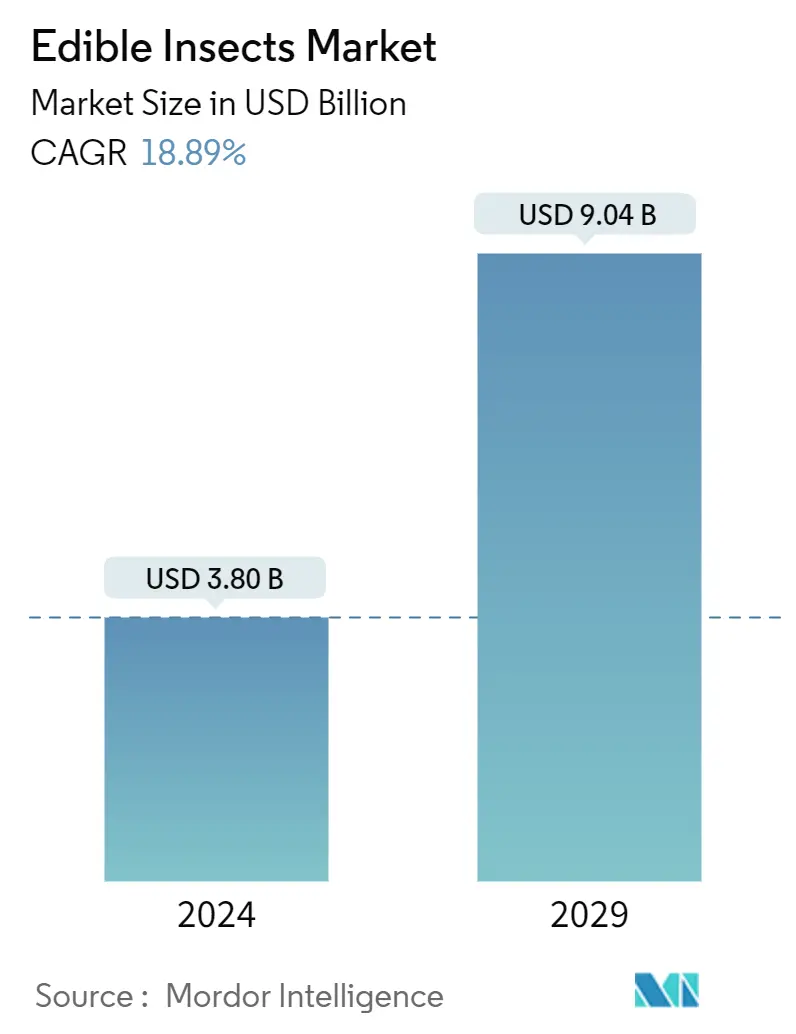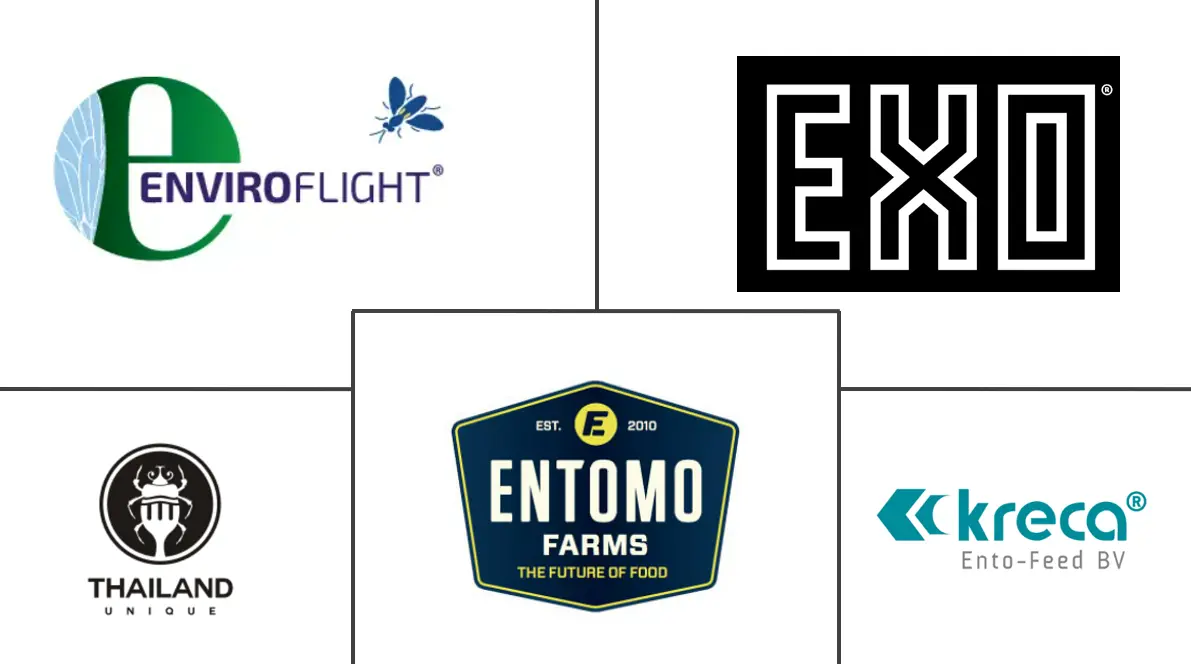Market Size of Edible Insects Industry

| Study Period | 2019 - 2029 |
| Market Size (2024) | USD 3.80 Billion |
| Market Size (2029) | USD 9.04 Billion |
| CAGR (2024 - 2029) | 18.89 % |
| Fastest Growing Market | Asia-Pacific |
| Largest Market | Europe |
Major Players
*Disclaimer: Major Players sorted in no particular order |
Edible Insects Market Analysis
The Edible Insects Market size is estimated at USD 3.80 billion in 2024, and is expected to reach USD 9.04 billion by 2029, growing at a CAGR of 18.89% during the forecast period (2024-2029).
- Entotarians (one whose diet includes insects but no other meats) is a novel concept that came into existence as a problem solver to feed the estimated 10 billion people that the world will have in some years. The growing number of entotarians has intensified the demand for edible insects worldwide.
- In addition, due to consumer desire for more sustainable and alternative food and feed products, the use of edible insects has been gradually developing. For instance, according to recent estimates, approximately 2,111 species of insects are consumed in about 140 countries, with entomophagy documented around the world like in Asia, Australia, Africa, and the Americas are already consumed regularly by people and domestic animals across the globe owing to their high protein, healthy fat, mineral, and vitamin content.
- The consumption of insects in the tropical and sub-tropical Asian regions from various insect groups in these regions. Insect-eating habits are not only associated with nutritional aspects but are also closely related to socio-cultural practices and religious beliefs. Edible insects are also used to complement diets with rich protein sources and ecologically sustainable sources of the region's food.
- According to the FAO Edible Insects from a Food Safety Perspective, Report 2021, there are some regulatory frameworks for edible insects in distinct countries to govern the production and commercialization of insects in food and feed supply chains. For instance, in the United States, in the year 2020, the food uses of edible insects, insect parts, or derivatives fall within the oversight of the United States of America Food and Drug Administration (FDA). As such, edible insects and insect-based food products must comply with the Federal Food, Drug, and Cosmetic Act (FD&C Act) and its implementing regulations. For example, if insects and insect derivatives are to be used as food or color additives, these uses must be approved by the FDA.
- Many government associations are developing numerous projects and initiatives to focus on investments, research, and industry partners to escalate the edible insects business globally. For instance, in October 2022, the Australian Centre for International Agricultural Research (ACIAR) collaborated with AgriFutures Australia and the International Centre for Insect Physiology and Ecology (ICIPE) to create a new research hub launched in Australia, which derives the emerging insect technology with industries using insects as human food, animal feed, fertilizer and other products such as oil.
Edible Insects Industry Segmentation
Insects as food or edible insects are insect species used for human consumption. More than 2,000 insect species worldwide are considered edible. Common forms of consumption are whole insects on one hand and pulverized insects used as an ingredient in dishes or in terms of processed food products such as burger patties, pasta, snacks, and many others. The Edible Insects Market is segmented by Insect Type into Beetles, Caterpillars, Hymenoptera, Orthoptera, Tree Bugs, and Other Insect Types, Product Type As A Whole, and As Ingredient, and Geography into North America, Europe, Asia-Pacific, South America, Middle-East & Africa. The report offers the market size and forecasts in terms of value in (USD Thousands) for all the above segments.
| Insect Type | |
| Beetles | |
| Caterpillar | |
| Hymenoptera | |
| Orthoptera | |
| Tree Bugs | |
| Other Insect Types |
| Product Type | ||||||
| ||||||
|
| Geography | ||||||||
| ||||||||
| ||||||||
| ||||||||
| ||||||||
|
Edible Insects Market Size Summary
The edible insects market is experiencing significant growth, driven by the increasing global population and the need for sustainable food sources. The concept of entotarians, individuals who include insects in their diet, is gaining traction as a solution to feed the world's growing population. This shift is supported by the rising consumer interest in sustainable and alternative food products. Edible insects, consumed in various regions such as Asia, Australia, Africa, and the Americas, are rich in protein, healthy fats, minerals, and vitamins, making them a nutritious addition to diets. The market is further bolstered by regulatory frameworks in countries like the United States, which oversee the production and commercialization of insects in food and feed supply chains. Government initiatives and collaborations, such as those in Australia, are also promoting research and investment in the edible insects industry.
Europe is at the forefront of the edible insects market, with increasing demand for protein-rich and diverse food sources. The market is supported by regulatory developments and consumer acceptance of insect-based foods. The European Union's novel food regulation has facilitated the commercialization of edible insects, contributing to the market's expansion. The market is characterized by fragmentation, with numerous new companies entering the space, focusing on product innovation and research to meet the growing demand. Prominent companies like Exo Inc., Thailand Unique, and Enviro Flight LLC are leading the market, while strategic partnerships and investments, such as those by Lotte Confectionery and InnovaFeed, are enhancing production capabilities and market presence.
Edible Insects Market Size - Table of Contents
-
1. MARKET DYNAMICS
-
1.1 Market Overview
-
1.2 Market Drivers
-
1.3 Market Restraints
-
1.4 Porter's Five Forces Analysis
-
1.4.1 Bargaining Power of Buyers
-
1.4.2 Bargaining Power of Suppliers
-
1.4.3 Threat of New Entrants
-
1.4.4 Threat of Substitute Products
-
1.4.5 Intensity of Competitive Rivalry
-
-
-
2. MARKET SEGMENTATION
-
2.1 Insect Type
-
2.1.1 Beetles
-
2.1.2 Caterpillar
-
2.1.3 Hymenoptera
-
2.1.4 Orthoptera
-
2.1.5 Tree Bugs
-
2.1.6 Other Insect Types
-
-
2.2 Product Type
-
2.2.1 As a Whole
-
2.2.1.1 BBQ
-
2.2.1.2 Stream or Fried
-
2.2.1.3 Raw
-
-
2.2.2 As a Ingredient
-
2.2.2.1 Drinks
-
2.2.2.2 Insect Confectionery
-
2.2.2.3 Snacks and Backed Products
-
2.2.2.4 Others
-
-
-
2.3 Geography
-
2.3.1 North America
-
2.3.1.1 United States
-
2.3.1.2 Canada
-
2.3.1.3 Mexico
-
2.3.1.4 Rest of North America
-
-
2.3.2 Europe
-
2.3.2.1 Germany
-
2.3.2.2 United Kingdom
-
2.3.2.3 France
-
2.3.2.4 Russia
-
2.3.2.5 Poland
-
2.3.2.6 Rest of Europe
-
-
2.3.3 Asia-Pacific
-
2.3.3.1 China
-
2.3.3.2 Japan
-
2.3.3.3 Thailand
-
2.3.3.4 Rest of Asia-Pacific
-
-
2.3.4 South America
-
2.3.4.1 Brazil
-
2.3.4.2 Argentina
-
2.3.4.3 Rest of South America
-
-
2.3.5 Middle-East & Africa
-
2.3.5.1 South Africa
-
2.3.5.2 Rest of Middle-East & Afric
-
-
-
Edible Insects Market Size FAQs
How big is the Edible Insects Market?
The Edible Insects Market size is expected to reach USD 3.80 billion in 2024 and grow at a CAGR of 18.89% to reach USD 9.04 billion by 2029.
What is the current Edible Insects Market size?
In 2024, the Edible Insects Market size is expected to reach USD 3.80 billion.

